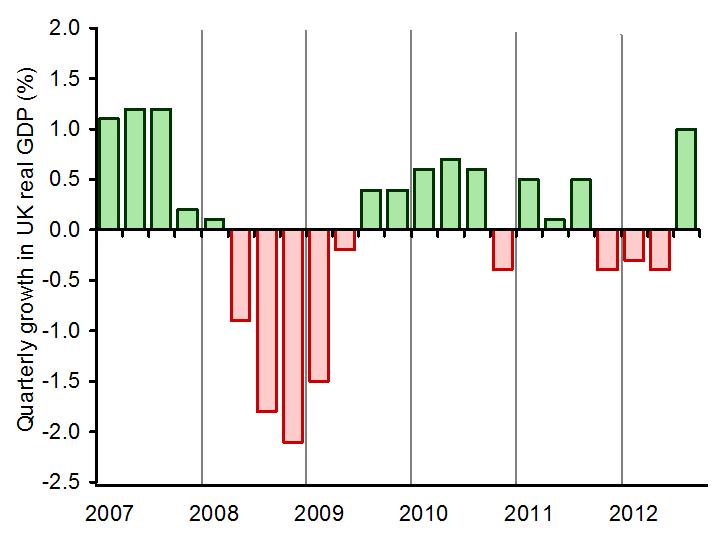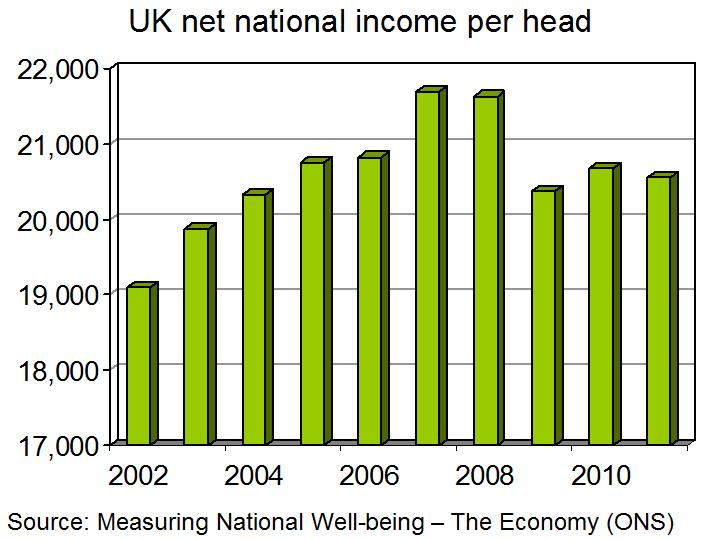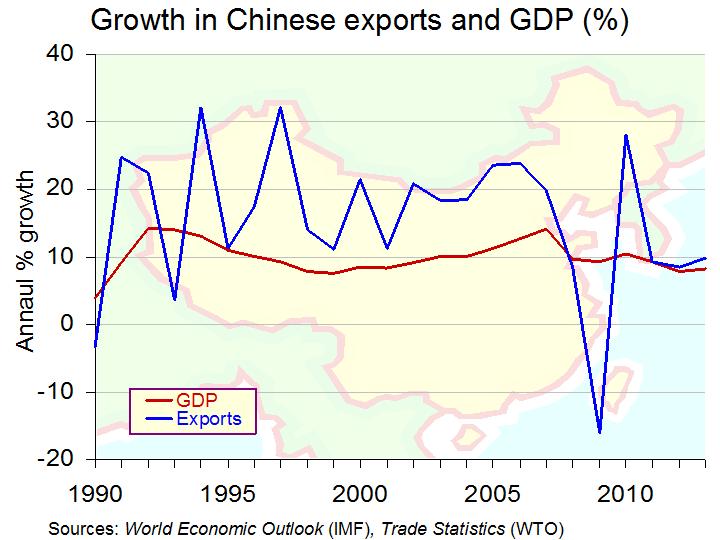 The story of the UK economy over the past few years has been one of bad news and worse news. With a double-dip recession having kept confidence low in the UK, positive news for the economy was seemingly a distant hope of government ministers. However, official statistics show that that in the 3 months from July to September, the UK economy emerged from recession, with growth of 1.0%.
The story of the UK economy over the past few years has been one of bad news and worse news. With a double-dip recession having kept confidence low in the UK, positive news for the economy was seemingly a distant hope of government ministers. However, official statistics show that that in the 3 months from July to September, the UK economy emerged from recession, with growth of 1.0%.
This positive GDP figure (click here for a PowerPoint of the chart below) was undoubtedly helped by the London Olympics over the summer, which may have added as much as 0.2 percentage points to GDP, according to the ONS. Millions arriving in London and other venues, spending money on countless things. Yet, other factors have also contributed to this welcome growth. Stephanie Flanders said:
The positive ‘surprise’ in these figures is largely to be found in the service sector, which is estimated to have growth by 1.3% in the third quarter, after shrinking by 0.1% in the three months before.
Further to this, in Stephanie Flanders’ ‘Stephanomics’, she says that ‘it confirms that the last three months of this latest recession were brought to you by the Queen. Or at least, the extra Bank Holiday to celebrate her Jubilee.’ The Bank of England suggests that the Jubilee took 0.5 percentage points from official GDP statistics. So, the news so far is positive, but the economy is far from being back to its pre-recession size.

The 2008-2009 recession knocked 6.4% off the UK economy. Since then, the total growth (over the past 4 years) has reached only half of that – 3.2% and that includes the 1% figure just published. Thus, while we may be on ‘the right track’, there is still a long way to go. Economists differ in their interpretations of what this means for the overall recovery: some say that this is a sign of what’s to come; others argue that this recovery has been driven by one-off factors.
What is certain is that government policy over the next few months will be crucial in keeping the economy on the right growth path. The following articles consider the implications of this new economic data.
A special recovery BBC News, Stephanomics, Stephanie Flanders (25/10/12)
UK GDP rises 1pc: economist reaction The Telegraph (25/10/12)
Nick Clegg warns economic recovery will be ‘fitful’ The Guardian, Daniel Boffey (28/10/12)
GDP figures set to show UK economy has exited double-dip recession The Telegraph, Philip Aldrick, Emma Rowley and Jessica Winch (25/10/12)
UK economy returns to growth with help from Olympics BBC News (25/10/12)
U.K. posts quarterly gain in GDP, lifted by Olympics Wall Street Journal, Cassel-Bryan Low (25/10/12)
GDP figures show UK emerging from recession: full reaction The Guardian (25/10/12)
UK growth signals move out of recession Financial Times, Sarah O’Connor and George Parker (25/10/12)
Questions
- How do we define a recession?
- How is GDP calculated and what does it measure?
- Which factors have contributed towards lower GDP data towards the beginning of this year?
- Which factors have helped boost GDP in the 3 months from July to September?
- Why is there disagreement about the likelihood of positive GDP figures continuing throughout the rest of the year?
- Prior to the official release of the GDP figures, David Cameron hinted at positive news. Given that the market is so sensitive, what effect might this suggestion have had?
- Given this positive figure, what implications does this have for the government’s quantitative easing programme?
- If we translate this latest growth data onto an AD/AS diagram, how would you show what has recently happened?
 Although every recession is different (for example in terms of length and magnitude), they do tend to have a few things in common. The focus of this blog is on consumer income and how it is affected in the aftermath of (or even during) a recession. According to data from the ONS, real national income per head has fallen by more than 13% since the start of 2008.
Although every recession is different (for example in terms of length and magnitude), they do tend to have a few things in common. The focus of this blog is on consumer income and how it is affected in the aftermath of (or even during) a recession. According to data from the ONS, real national income per head has fallen by more than 13% since the start of 2008.
This latest data from the Office of National Statistics shows that in the aftermath of the 2008 recession, UK incomes have fallen by much more than they did in the 2 previous recessions experienced in the UK (click here for a PowerPoint of the chart). We would normally expect consumer incomes to fall during and possibly directly after a recession, as national output falls and confidence tends to be and remain low. However, the crucial thing to consider with falling consumer incomes is how it affects purchasing power. If my income is cut by 50%, but prices fall by 80%, then I’m actually better off in terms of my purchasing power.

The data from the ONS is all about purchasing power and shows how UK consumer incomes have fallen at the same time as inflation having been relatively high. It is the combination of these two variables that has been ‘eating into the value of the cash that people were earning’. Comparing the incomes in the four years after the 2008 recession with similar periods following the early 1980s and 1990s recession, the ONS has shown that this most recent recession had a much larger effect on consumer well-being. Part of this may be due to the rapid growth in incomes prior to the start of the credit crunch.
It’s not just the working population that has seen their incomes fall since 2008 – the retired population has also seen a decline in income and according to a report from the Institute for Fiscal Studies, it is the wealthiest portion of older households that have taken the largest hit since 2007. According to the IFS, the average person over 50 has experienced a fall in their gross wealth of about 10%, or close to £60,000. Of course for these older households, the concern is whether they will be able to make up this lost wealth before they retire. The concern for everyone is how long until incomes and purchasing power increase back to pre-crisis levels. The following articles consider this latest data on economic well-being and the impact the recession has had.
UK wellbeing still below financial crisis levels Guardian, Larry Elliott and Randeep Ramesh (23/10/12)
National income per head ‘down 13% in four years’ BBC Newsd (23/10/12)
Financial crisis hits UK retirement income Financial Times, Norma Cohen (23/10/12)
Over 50s ‘left £160,000 out of pocket by the financial crisis’ The Telegraph, James Kirkup (23/10/12)
Those near retirement in UK hit hard by crisis Wall Street Journal, Paul Hannon (23/10/12)
Living standards down 13pc since start of recession The Telegraph (23/10/12)
Questions
- Why is net national income per head said to be the best measure of economic well-being?
- Why is it so important to take into account inflation when measuring wellbeing?
- What explanation can be given for the larger fall in consumer incomes following the 2008 recession relative to the previous 2 recessions?
- According to data from the IFS, the richest portion of older households have suffered the most in terms of lost wealth. Why is this the case?
- What is meant by purchasing power?
- GDP has fallen by about 7%, whereas national income per head, taking inflation into account is down by over 13%. What is the explanation for these 2 different figures?
- How can recessions differ from each other? Think about the length, the magnitude of each.
- Is GDP a good measure of economic well-being? Are there any other ways we can measure it?
 China has been one of the success stories of the past 20 years, with rapid growth in domestic and export demand. This has created the second largest economy in the world. From 1992 to 2007 annual GDP growth averaged 10.7% and annual export growth averaged 18.9% (see chart).
China has been one of the success stories of the past 20 years, with rapid growth in domestic and export demand. This has created the second largest economy in the world. From 1992 to 2007 annual GDP growth averaged 10.7% and annual export growth averaged 18.9% (see chart).
However, with the credit crunch and ensuing recession, growth rates in China have fallen somewhat. Annual GDP growth has averaged 9.6% and annual export growth has averaged 7.4%. Such growth rates may not seem bad, given that many Western economies have been struggling to achieve any growth, but they have been causing concern for this booming economy.
 In its May Outlook, the World Bank forecast China’s growth for the year at 8.2%, but it has since been reduced to 7.8%. A key part of China’s success story has been its export market, but it has been this market that has caused concerns for the mainland economy. In August of this year, its year-on-year export growth was at only 2.7%, but exports last month grew by more than expected, at approximately 7.4%. China has had a consistent trade surplus and according to government figures, this has widened to $27.67 billion in September from $26.66 billion in the previous month.
In its May Outlook, the World Bank forecast China’s growth for the year at 8.2%, but it has since been reduced to 7.8%. A key part of China’s success story has been its export market, but it has been this market that has caused concerns for the mainland economy. In August of this year, its year-on-year export growth was at only 2.7%, but exports last month grew by more than expected, at approximately 7.4%. China has had a consistent trade surplus and according to government figures, this has widened to $27.67 billion in September from $26.66 billion in the previous month.
Recovery in this market will be crucial for the continued success of the economy, as a means of alleviating the fears of a slowdown. This higher growth of exports may be a misleading indicator, perhaps influenced by seasonal factors and thus may not be a sign of what’s to come. Indeed, many analysts have said that they are not convinced that these healthier trade figures will remain. Alistair Thornton, from IHS Global Economics said:
“It’s safe to say we are overshooting the trend here and we expect (the data) to come back in line in the months ahead.”
Citigroup economist, Ding Shaung also confirmed these sentiments:
”The trade data is a positive sign for the Chinese economy … But it remains to be seen whether import and export growth can remain at these levels.”
Part of this pessimism is due to the uncertainty surrounding the growth prospects of its biggest two trading partners – the US and the European Union. Exports to the former have remained relatively high, but exports to the European Union have suffered, falling by over 5.6%. It is likely that weaknesses in the global economy have held back China’s growth prospects in both exports and national output. The Chinese government was aiming for growth of 7.6% in 2012. Not a bad rate you may say, but when compared with growth rates for 2011 (9.3%) and 2010 (10.4%), it does represent a significant fall. The future of the Chinese economy is crucial for the recovery of the world economy, in part as it represents a big demand for imports from other countries, such as the US and Europe. The following articles consider the trade and growth prospects of the world’s second largest economy.
Chinese exports grow faster than expected in September BBC News (14/10/12)
Chinese exports grow faster than expected Financial Times, Patti Waldmeir (14/10/12)
China exports jump, but weaknesses seen ahead The Korea Herald (14/10/12)
China exports rise, hinting at a glimmer of revival New York Times, Keith Bradsher (13/10/12)
China’s trade surplus widens Wall Street Journal, William Kazer (13/10/12)
Chinese surplus widens as exports surge CNN, Paavan Mathemas (13/10/12)
 China’s economic slow-down BBC Today Programme, Linda Yueh (18/10/12)
China’s economic slow-down BBC Today Programme, Linda Yueh (18/10/12)
Questions
- What is a trade surplus?
- Which factors have influenced Chinese exports and imports?
- Why is China’s growth rate such an important variable for the UK and other Western economies?
- Why has export growth in China fallen recently? Can you use the same explanation for its lower growth in national output?
- Explain why analysts remain pessimistic about the sustainability of these improved trade figures.
- Using a diagram, illustrate the effect that higher Chinese growth rates will have on GDP in a country such as the UK. Could there be a multiplier effect?
 With the winter fast approaching, consumers have already begun to stock up on warmer clothes. This has contributed towards consumer spending increasing faster in September than it has in the past 3 years. According to Visa Europe’s UK expenditure index, sales in August increased by 1.2pc, but in September they rose month-on-month by 3pc.
With the winter fast approaching, consumers have already begun to stock up on warmer clothes. This has contributed towards consumer spending increasing faster in September than it has in the past 3 years. According to Visa Europe’s UK expenditure index, sales in August increased by 1.2pc, but in September they rose month-on-month by 3pc.
But whilst sales on the high-street increased, sales on-line and over the telephone declined. It seems that the recent decrease in temperature is just what the retail sector ordered, as people took to the high streets.
Furthermore, recent improvements in consumer income, together with lower inflation and rising employment have all contributed towards a growth in spending. However, as consumer confidence remains at a relatively low level, it is unlikely that the winter will bring much of a change to growth in the economy. The Chief Economist at Markit said:
However, consumer confidence remains historically low as uncertainty about the economy and job security persists, suggesting that the bounce in spending seen in the third quarter could be as good as it gets for the foreseeable future.
 Although the lower temperature has caused a boost in consumption, once people have made their ‘investment’ in warmer clothes, retail spending may once again decline. Hence the above comment by Markit, which suggests that further sustained increases in consumer spending may still be some way off.
Although the lower temperature has caused a boost in consumption, once people have made their ‘investment’ in warmer clothes, retail spending may once again decline. Hence the above comment by Markit, which suggests that further sustained increases in consumer spending may still be some way off.
The following few articles look at the latest data on retail spending.
UK consumer spending ‘rose in September’ BBC News (5/10/12)
Consumer spending increases by 3pc The Telegraph (5/10/12)
Consumer spending increases by 3% The Press Association (5/10/12)
UK retail sales: what the analysts say Guardian (20/9/12)
Online sales and wet weather boost John Lewis Scotsman, Peter Ranscombe (5/10/12)
Questions
- Which factors typically affect consumer spending?
- Using a diagram, illustrate the impact of this increase in consumption on national output and the price level.
- Is it possible that a multiplier effect may occur with the August and September rise in retail sales?
- Why is consumer confidence remaining low? Which components of aggregate demand does it affect?
- Explain why (a) lower inflation, (b) the colder weather and (c) rising employment have caused consumer spending to rise.
 The UK has always been an attractive place for investment, as foreign companies look to cities such as London for stable investment opportunities. This provides not only jobs and output, but also tax revenue for the government. However, one drawback is the lost tax revenue through tax avoidance schemes and big businesses say that if the UK is to remain competitive it needs to look at cutting taxes and bureaucracy.
The UK has always been an attractive place for investment, as foreign companies look to cities such as London for stable investment opportunities. This provides not only jobs and output, but also tax revenue for the government. However, one drawback is the lost tax revenue through tax avoidance schemes and big businesses say that if the UK is to remain competitive it needs to look at cutting taxes and bureaucracy.
In recent months, we have seen cases of individuals being prosecuted for tax evasion and more recently in the USA, Microsoft and Hewlett-Packard have been criticized by the Senate for allegedly moving an estimated £13bn to offshore accounts. (Microsoft and HP deny any wrong-doing). It is cases like this that provide an argument for governments to cut business rates and avoid losing business and jobs to other tax havens. Lord Fink, who is a Director of Firms located in a variety of tax havens said:
’I don’t see why the UK should not compete for jobs that at present are going to the Cayman Islands’
 Tax havens are obviously attractive to firms, as they provide a means of retaining more of a firm’s earnings and hence their profits. By offering a much lower rate of tax than countries such as the UK, they help to ease the tax burden on wealthy individuals and investors in hedge funds, along with many others.
Tax havens are obviously attractive to firms, as they provide a means of retaining more of a firm’s earnings and hence their profits. By offering a much lower rate of tax than countries such as the UK, they help to ease the tax burden on wealthy individuals and investors in hedge funds, along with many others.
The question is, do these lower tax rates discourage investment into the UK and thus would a relaxation of Revenue Customs’ rules mean an increase in inward investment and the other positive things that this would bring? Or would a decrease in tax rates for wealthy investors send the wrong message?
 In a time of austerity, tax cuts for the rich are never going to be a popular policy – at least not amongst the ‘non-rich’ – in truth, the majority of the population. Furthermore, many simply see tax havens as morally wrong – or as George Osborne put it ‘morally repugnant’. The use of them provides the better off with a means of paying less to the taxman, whilst the worse off continue to pay their share.
In a time of austerity, tax cuts for the rich are never going to be a popular policy – at least not amongst the ‘non-rich’ – in truth, the majority of the population. Furthermore, many simply see tax havens as morally wrong – or as George Osborne put it ‘morally repugnant’. The use of them provides the better off with a means of paying less to the taxman, whilst the worse off continue to pay their share.
The controversy surrounding tax havens is perhaps even more of an issue given the size of the public-sector deficit. With tax havens being used by those who should be paying the most, tax revenues are lower than would be the case without tax evasion and avoidance. Is this adding to the burden of basic rate tax payers?
This doesn’t help the gap between government expenditure and revenue, which has contributed to the largest amount of UK public-sector borrowing in August 2012 since records began. Net borrowing reached £14.4bn, as things like corporation tax receipts fell and benefit payments rose. Money that should go in to the government’s coffers is undoubtedly making its way into tax havens, but does that also mean that jobs are making their way out of the country? If tax rates in the UK were cut, cities such as London may become even more attractive places to invest, which could potentially create a much needed boost for the economy. But, at what cost? The following articles consider the controversy of tax havens.
Microsoft and HP rapped by US Senate over tax havens BBC News (20/9/12)
Morally repugnant tax avoiders can rest easy under David Cameron Guardian, Tanya Gold (21/9/12)
Britain could prevent the use of tax havens by ending ‘archaic’ business rules Telegraph, Rowena Mason (21/9/12)
UK public-sector borrowing hits record high of £14.4bn BBC News (21/9/12)
The top Tory who wants to make Britain a tax haven for millionaires Guardian, Martin Williams and Rajeev Syal (20/9/12)
Make UK a tax haven to attract investment from millionaires, urges Tory treasurer Mail Online, Daniel Martin (21/9/12)
Microsoft saved billions using Irish tax havens Irish Times, Genevieve Carbery (21/9/12)
Microsoft, HP skirted taxes via offshore units: U.S. Senate Panel Reuters, Kim Dixon (21/9/12)
Danny Alexander says tax avoidance ‘adds 2p in every £1 to basic tax rate’ Independent, Oliver Wright (24/6/12)
Questions
- What are the key features of tax havens?
- Briefly explain the arguments in favour of tax havens and those against. Think about them from all points of view.
- Explain the way in which a cut in UK tax rates could create jobs and how the multiplier effect may provide a boost for the UK economy.
- If tax rates were cut, how might this affect an individual’s decision to work? What about an individual’s decision to invest? Use indifference analysis to help explain your answer.
- How does tax avoidance and evasion affect public sector borrowing? Is there any way a cut in tax rates on foreign investment could improve the government’s finances?
- Do you think there is any truth in the argument that the UK is losing out to other countries because of its higher tax rates? Is a reduction in tax rates necessary to help us compete?
 The story of the UK economy over the past few years has been one of bad news and worse news. With a double-dip recession having kept confidence low in the UK, positive news for the economy was seemingly a distant hope of government ministers. However, official statistics show that that in the 3 months from July to September, the UK economy emerged from recession, with growth of 1.0%.
The story of the UK economy over the past few years has been one of bad news and worse news. With a double-dip recession having kept confidence low in the UK, positive news for the economy was seemingly a distant hope of government ministers. However, official statistics show that that in the 3 months from July to September, the UK economy emerged from recession, with growth of 1.0%.









